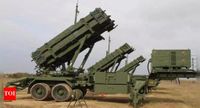In a dramatic escalation of hostilities, India successfully repelled a series of drone and missile attacks launched by Pakistan on the night of May 8-9, 2025. The Indian Armed Forces activated their full air defense network, effectively neutralizing over 50 swarm drones and multiple missile threats aimed at key military installations and civilian areas across 15 cities.
According to reports, the Pakistani Armed Forces initiated these attacks as part of a broader strategy to breach the Line of Control (LoC) and International Borders. Locations targeted included Jammu, Pathankot, Udhampur, and various sectors in Punjab and Rajasthan. The Indian Army confirmed that all attacks were thwarted, stating, "The drone attacks were effectively repulsed and a befitting reply was given to the ceasefire violations (CFVs)."
The Indian Air Force (IAF) utilized a range of advanced weaponry, including Counter-Unmanned Aerial Systems (CUAS), Pechora missiles, SAMAR systems, and traditional air defense guns. The CUAS system played a crucial role, specifically designed to counter drone threats in low-altitude environments like Jammu and Kashmir. This system boasts a quick reaction time and low-cost drone destruction capabilities, developed indigenously by the Indian Army.
One of the key components in India's defense arsenal, the Pechora (S-125 Neva/Pechora), has been instrumental in intercepting both drones and missiles. With a range of 3.5 to 25 kilometers, it can effectively engage various aerial threats, including fighter jets and cruise missiles. The IAF operates over 25 Pechora squadrons, which are currently undergoing modernization through digital upgrades.
Alongside Pechora, the SAMAR (Surface-to-Air Missile for Assured Retaliation) system, also developed by the Defence Research and Development Organisation (DRDO) and the IAF, has proven effective against low-flying targets such as drones and helicopters. It has a range of approximately 10-12 kilometers, emphasizing India's commitment to developing indigenous defense capabilities.
As the conflict unfolded, blackouts were enforced across several states, including Jammu and Kashmir, Punjab, and Rajasthan, as a precautionary measure against potential further strikes. Explosions and sirens echoed through the night, prompting panic among residents. In Jammu, a sudden power outage occurred following two loud explosions believed to be linked to the interception of the intruding drones.
The situation escalated following Operation Sindoor, an Indian offensive targeting terror infrastructure in Pakistan and Pakistan-Occupied Kashmir (POK), which was launched in retaliation for a recent terror attack in Pahalgam that killed 26 civilians, primarily tourists. This operation appears to have provoked Pakistan's recent aggressive actions.
In response to the Pakistani strikes, India also conducted retaliatory strikes using Harop and Harpy drones aimed at destroying enemy air defense infrastructure near Lahore. This marks a significant development in India's military strategy, showcasing its growing capabilities in precision operations.
Defence Minister Rajnath Singh addressed the nation amidst rising tensions, affirming India's readiness to protect its sovereignty. "No limit will become an obstacle to protecting India's sovereignty. India has always exercised restraint and believes in resolving issues through dialogue. But if anyone mistakes this restraint for weakness, they will face quality action," he stated.
The Indian Air Force's layered air defense system, often referred to as the Air Defence Umbrella, includes a mix of indigenous and imported systems, such as the Akash missile system, the Russian S-400 Triumf, and the Israeli Barak-8. The Akash missile, developed by DRDO, has a range of 25 kilometers and is designed to intercept various aerial threats, reinforcing India's self-reliant defense policy.
As the conflict continues to unfold, security agencies across India have been placed on high alert, with increased patrols in border areas and advisories issued to civilians to remain vigilant. The ongoing military exchanges have raised concerns about a potential broader conflict between the two nuclear-armed neighbors.
In summary, the events of May 8-9, 2025, mark a significant moment in the ongoing tensions between India and Pakistan, highlighting the critical role of air defense systems in modern warfare and the strategic importance of maintaining readiness in the face of aggression.






